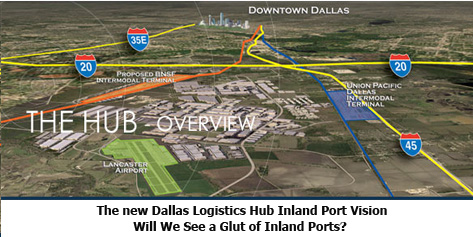Many New Projects
Inland Ports have been around for many years. The one in Sacramento, CA opened in 1947, for example. Cincinnati operates a busy Inland Port on the Ohio River, servicing barge traffic. An 11,600-acre Inland Port in Alliance, TX opened in 1990. Another successful Inland Port is operating in Front Royal, VA.

However, a number of Inland Ports have either recently been built or are somewhere in the planning or development stages. Examples include:
- Dallas Logistics Hub: opened in April, 2007, it is the largest new logistics park under development in North America, with 6,000 acres of land and the potential for 60 million vertical square feet of distribution, manufacturing and retail development. It will compete with the older development in nearby Alliance, TX.
- Freight Gateway and Intermodal Center near Kansas City, which is undergoing significant development. Kansas City Southern railroad plans to start operating its new intermodal facility there on March 14.
- Another Texas-based Inland Port is being built near San Antonio, as are new Inland Port facilities in Virginia, California, and North Carolina.
West Virginia is also getting into the act. An Inland Port facility is under development in Prichard, southwest of Huntington, as part of the Heartland Corridor project that received $153 million in federal funding in 2005. It expects to link by rail to the port in Norfolk, VA 500 miles away.
Is An Inland Port Glut Looming?
The development comes at an interesting time. Of late, a combination of slowing import growth, port efficiency gains, and other factors have dramatically reduced congestion issues at existing ports in 2007. While many expect the long-term trend to see renewed logistics pressures at the port, current conditions may cause some to revisit assumptions.
It also seems likely that this simply won’t be enough business for all the Inland Ports under development. North Carolina’s Global Trans-Park, opened in 1991, has never met expectations, for example, and requires state subsidies to shore up operating losses resulting from lower projected volumes. A proposal for an Inland Port in South Carolina collapsed last year amid scandal with the company making the proposal for government funding for the project.
Some Inland Ports that can be served by waterways may get a boost from various green initiatives that see ship transport of cargo as one solution to environmental and congestion woes.
Are you using Inland Ports? Why – or why not? Do you think we may be getting too much development of Inland Ports, which may lead to a glut of capacity and require too much government financial support? Let us know your thoughts at the Feedback button below. |